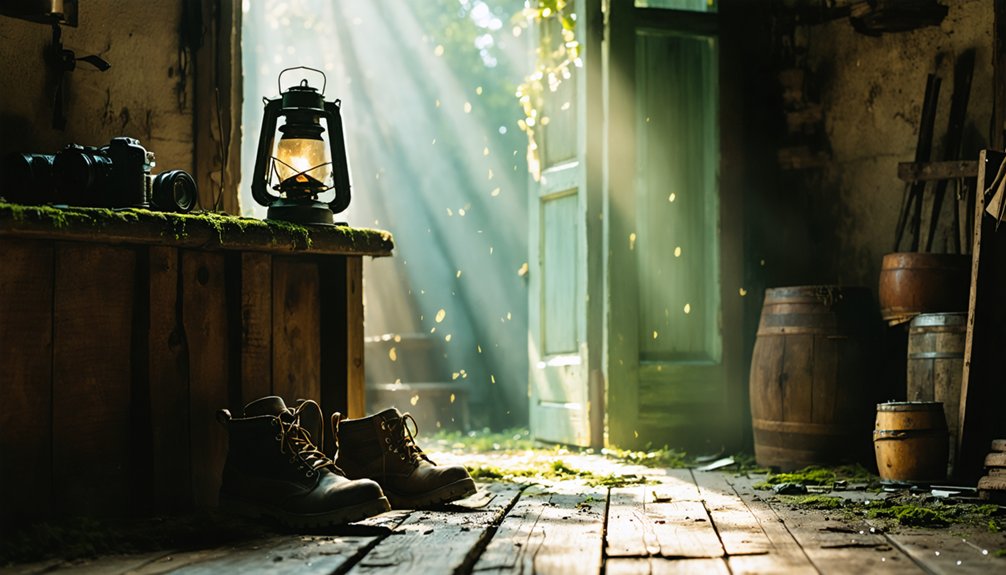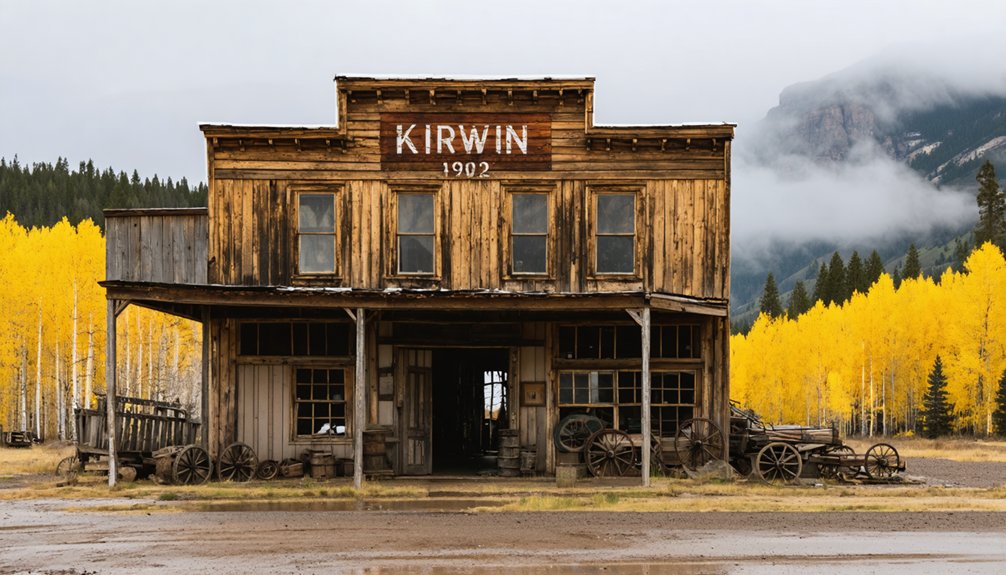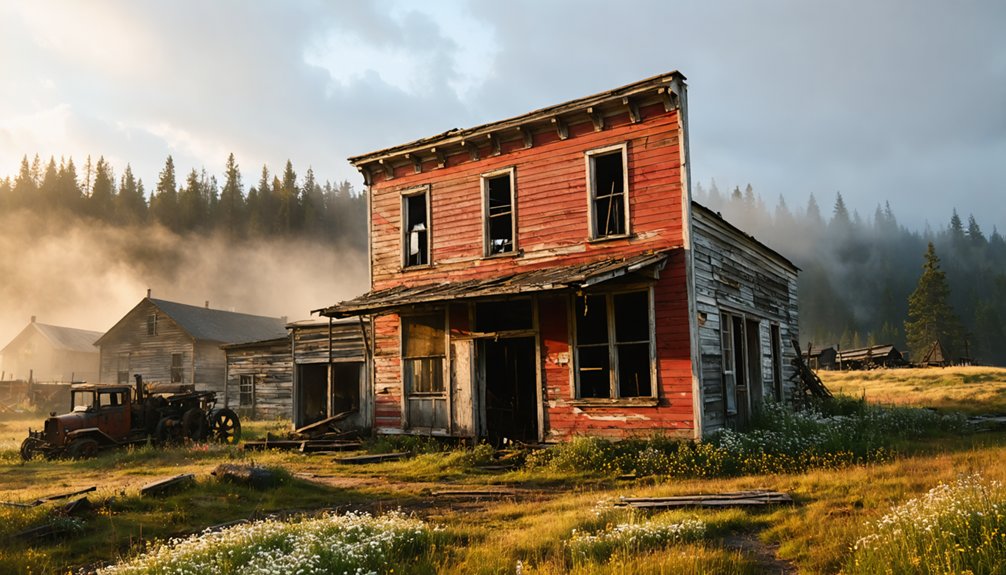Within 2.5 hours of Portland, you’ll find fascinating ghost towns like Bridal Veil, Boyd, and Shaniko. Visit during summer months for ideal exploration conditions, but pack essentials: sturdy boots, flashlights, maps, and cameras. Always respect “No Trespassing” signs and preservation laws while documenting these historic sites. Consider day trips to nearby towns or extend your adventure to eastern Oregon’s abandoned clusters. The stories behind these forgotten communities will transport you to Oregon’s ambitious past.
Key Takeaways
- Five accessible ghost towns near Portland include Bridal Veil, Boyd, Friend, Shaniko, and Antelope, all within 2.5 hours driving distance.
- Summer months (June-August) offer optimal exploration conditions with minimal rain, while winter can limit access due to snow and ice.
- Pack essentials including sturdy footwear, lighting equipment, navigation tools, safety supplies, and photography gear for documentation.
- Respect legal boundaries, seek permission before entering private properties, and avoid removing artifacts or damaging structures.
- Consider day trips to nearby towns like Bridal Veil or extended adventures to Eastern Oregon’s clusters of abandoned communities.
Plan Your Ghost Town Road Trip Route

While Portland’s urban landscape offers plenty of modern attractions, the true adventurer knows that some of Oregon’s most fascinating history lies just beyond the city limits in its abandoned settlements.
Within a 2.5-hour drive, you’ll find Bridal Veil, Boyd, Friend, Shaniko, and Antelope—each with its own story to tell.
Oregon’s forgotten chapters await just beyond Portland—five ghost towns, five distinct histories, all within an afternoon’s journey.
Navigate the scenic routes through the Columbia River Gorge via I-84 East, then connect to US 197 South or Highway 97 North depending on your destination. For Shaniko specifically, take either I-84 East to Highway 197 South then Bakeoven Road, or follow Highway 26 East to Highway 216 East and continue to Highway 197 South—both routes offer scenic drives from Portland.
Road conditions vary from smooth highways to rural gravel paths near smaller settlements. Download offline maps before departing, as cell reception disappears in these remote areas.
Most ghost towns are accessible year-round, but winter weather can complicate travel, especially on secondary roads. Oregon has over 200 ghost towns scattered throughout the state, providing numerous options for exploration beyond those mentioned here.
Best Times to Visit Portland’s Abandoned Towns
Timing makes all the difference when exploring Portland’s forgotten settlements. Summer months (June-August) offer the ideal balance of accessibility and comfort, with July providing peak exploration conditions despite larger crowds. Weather considerations greatly impact your ghost town experience throughout the year.
- June through August presents excellent conditions: minimal rain, maximum daylight, and best road access to remote locations.
- September and May offer a sweet spot with moderate crowds and reasonable weather.
- Winter months (December-February) limit access with potential snow, ice, and road closures.
- November should be avoided due to being the wettest month with 17 rainy days.
- Fall brings beautiful colors but increasingly wet conditions as October shifts to November.
The best seasons for ghost town adventurers are unquestionably summer and early fall when freedom of movement isn’t constrained by weather. For those interested in potentially experiencing supernatural encounters, consider joining one of Portland’s ghost tours that operate nightly regardless of weather conditions. Remember that all 90-minute loops are led by local experts who share fascinating historical context about the area.
Essential Gear for Ghost Town Exploration

Properly equipped explorers stand the best chance of safely uncovering Portland’s hidden ghost towns while preserving their historical integrity.
Start with durable clothing protection: sturdy hiking boots, gloves, and weather-appropriate layers that shield you from debris and the Pacific Northwest’s unpredictable elements.
The Pacific Northwest demands respect—armor yourself with proper footwear, protective gloves, and versatile clothing before confronting its forgotten places.
Your lighting equipment should include a powerful primary flashlight, hands-free headlamp, and extra batteries for both. Consider a tactical torch like the BSS V3 Flashlight with high lumens output for exploring darker structures.
Don’t forget essential navigation tools—reliable maps, compass, and a multi-tool can prove invaluable when traversing forgotten paths. Download offline maps in advance for areas with poor cellular reception.
Always carry safety supplies including a first aid kit, plenty of water, and a fully-charged communication device.
For documentation gear, pack a camera to capture historic structures and perhaps an EMF meter if you’re hoping to detect paranormal activity in these abandoned remnants of Oregon’s past.
Photographing Historical Structures Responsibly
Documenting ghost towns through photography preserves their historical significance for generations, but requires adherence to ethical guidelines and technical standards.
Your images may become essential historical documentation that researchers rely on decades from now.
- Always obtain permission before photographing structures on private property—respect boundaries as you’d your own.
- Shoot with the sun at your back, ideally during early morning or late afternoon for ideal lighting conditions.
- Capture contextual shots showing the structure’s relationship to its environment before focusing on architectural details.
- Use high-resolution settings (minimum 300 ppi) to guarantee your images can be archived properly.
- Include scale references and directional indicators for each photograph to provide proper context for future researchers.
Remember that personal use only is typically allowed without special permission, but commercial photography of historical sites often requires written authorization.
Ethical photography practices guarantee these fragile remnants of Oregon’s past continue telling their stories authentically.
Understanding the Stories Behind These Lost Communities

Behind every abandoned storefront and crumbling foundation lies a complex tale of human ambition, struggle, and adaptation that shaped Oregon’s frontier landscape.
When you visit these lost communities, you’re walking through chapters of Oregon’s economic history—from gold mining boomtowns to timber camps that once buzzed with activity.
The historical significance of these settlements extends beyond their industries. Oregon has the highest number of ghost towns in the entire country, with approximately 200 counted throughout the state.
You’ll discover diverse social fabrics where churches, schools, and saloons formed community hubs.
Towns like Maxville reveal complex community dynamics through segregated baseball teams that eventually played in regional tournaments together.
Historian Stephen Arndt has documented 256 ghost towns throughout Oregon, many with fascinating stories of boom and bust cycles.
Others, like Antelope, experienced dramatic social upheavals that tested residents’ resilience.
Understanding these narratives transforms your ghost town experience from mere sightseeing to a meaningful connection with the determined pioneers who built—and eventually left—these remarkable places.
As you explore Oregon’s forgotten settlements, the legal boundaries of your adventure require careful attention. Most ghost towns near Portland sit on private land where trespassing laws apply regardless of a property’s abandoned appearance. Property rights remain intact even when buildings have decayed.
- Always seek permission before entering—property owners can prosecute trespassers even without “No Trespassing” signs.
- Respect historic preservation regulations that protect these time capsules from alteration.
- Be aware that removing artifacts or damaging structures violates state preservation laws.
- Vacant properties must be registered with Portland authorities, and owners actively monitor them.
- Financial institutions often own these properties after foreclosures, and they enforce access restrictions.
Without permission, you may be classified as a squatter or trespasser depending on how you interact with the property.
Your freedom to explore comes with responsibility to honor both legal boundaries and the fragile history these sites contain.
Day Trip Options vs. Extended Ghost Town Adventures

Portland’s proximity to historic ghost towns offers explorers both quick day trips and immersive multi-day adventures, depending on your available time and curiosity level.
For day trip benefits, consider Bridal Veil, just 30 minutes east of Portland, or venture slightly further to Boyd and Friend near The Dalles, where historic granaries and cemeteries await curious visitors.
Shaniko, about 2-3 hours away, delivers preserved structures with minimal driving commitment.
Extended exploration reveals deeper experiences in Eastern Oregon’s ghost town clusters. You’ll need multiple days to properly discover Sumpter, Bourne, Granite, and others, while enjoying gold panning at Sumpter Valley Dredge or hiking the Elkhorn Crest Trail.
These longer trips also align with local events and provide time for proper exploration of more remote locations with limited amenities.
Frequently Asked Questions
Are There Guided Tours Available for Any of These Ghost Towns?
Yes, you’ll find numerous guided experiences with companies like Ghost City Tours and Slabtown Tours offering historical insights through walking, driving, and paranormal investigation formats—most require advance reservations and accommodate small groups.
Can I Bring My Dog When Exploring These Abandoned Locations?
Yes, you can bring your dog to most ghost towns, but know that leash requirements apply in all state parks. Dog-friendly policies vary, so always check local regulations beforehand.
How Accurate Are GPS Directions to These Remote Ghost Towns?
Lost in time and technology? GPS reliability often falters in Oregon’s remote ghost towns. You’ll need paper maps as backup when your digital navigation fails in these signal-scarce desert locations.
Are There Camping Options Near Any of These Locations?
Yes, you’ll find camping near all four ghost towns. Pack proper camping gear for self-sufficiency, especially at Shaniko and Antelope where options are limited. Always check local regulations before setting up your wilderness home.
What Wildlife Encounters Should I Prepare for When Visiting?
You’ll encounter black-tailed deer, coyotes, and possibly rattlesnakes. Watch for wildlife signs, maintain distance for safety, and understand animal behavior patterns. Always carry deterrents and secure food properly.
References
- https://www.visitoregon.com/oregon-ghost-towns/
- https://www.pdxmonthly.com/travel-and-outdoors/oregon-ghost-towns
- https://thatoregonlife.com/2016/04/road-trip-ghost-towns-eastern-oregon/
- https://en.wikipedia.org/wiki/List_of_ghost_towns_in_Oregon
- http://www.photographoregon.com/ghost-towns.html
- https://traveloregon.com/things-to-do/culture-history/ghost-towns/
- https://www.overlandbound.com/forums/threads/ghost-towns-in-oregon.20177/
- https://www.pinesnvines.com/adventures/oregons-coolest-ghost-town
- https://www.youtube.com/watch?v=GaS3xjrQ-_I
- https://lizzie-borden.com/ghost-tours/portland/



